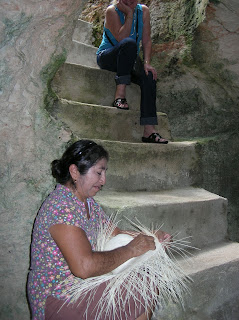The tiny pueblo of Becal lies 80 kilometers southeast of Merida, Yucatan, just over the border in the state of Campeche. Becal’s population of approximately 6,500 is a friendly and hospitable group whose smiles could easily challenge those of a Cheshire cat! A happy group of industrious folks, still steeped in Mayan traditions, will welcome you with open arms.
 Other than smiling faces, Becal has only one industry and that is weaving. Hats, purses, jewelry, baskets, and other trinkets are all hand woven by individual families, not factories. And they are the best of the best when it comes to hand weaving, the art of which has been passed down from generation to generation.
Other than smiling faces, Becal has only one industry and that is weaving. Hats, purses, jewelry, baskets, and other trinkets are all hand woven by individual families, not factories. And they are the best of the best when it comes to hand weaving, the art of which has been passed down from generation to generation.The trip there began without fanfare and a map. Unfortunately, unlike a “Trip-Tik” map from Triple A Motor Club of America, our map didn’t show any of the road construction and we were forced to navigate numerous detours to the point that we actually missed our turn off. I must add that it wasn’t our fault as there were no signs!
As soon as we entered by the main square in Becal, we somehow picked up an escort on a bicycle. His name was Paco, about 15 or 16 years old, and he obviously knew all the hot spots of Becal. He offered to take us to some homes that were open and offering their goods for sale and he also offered to show us the best place to eat in town. I’m 100% sure he was either related to these folks, or at the very least, knew them well.
We followed him to an unassuming little house where the senora welcomed us with a broad smile. We entered a small, very clean home and were encouraged to go to the backyard area where the gruta (cave) was and enjoy its coolness. It’s been said that most homes in Becal sport a small gruta in their backyard. I recall that when I had visited there some 20+ years ago, I remembered seeing many such caves in the backyards of the local towns people.
You might ask, “why a small cave in the backyard”? It all has to do with the processing of the jibi (palm frond leaves) that are required for the construction of the hats and such. The whole process starts with the selection of the palm frond, and this determines the quality of the hat. The palms are dried on clothes lines and then stripped into long sections, ready for weaving. The finer the palm frond, the better quality the hat is.
The hats are hand woven and then placed inside the grutas to cure. The grutas are cool and very humid and the dried palm fronds absorb the humidity and add permanent shaping to the hats as they cure. When the process is complete, the better hats can be folded or rolled and will bounce back to shape in an instant.
Hats range in price from 4,000 pesos (approximately $308.00 US) to 200 pesos ($15.50 US). The old cliché, “you get what you pay for” definitely holds true here. The hats sold by the vendors on the streets of Merida are usually the lesser quality hats, and the vendors try and get as much as possible for one, usually averaging around 250+ pesos per hat.
I opted not to buy a hat as I have several at home, but some friends along on the trip each purchased a very nice hat. I purchased a hand woven skeleton and a colorful rosary, as shown in the photo below. The senora holding the rosary is the one who wove them. Having enjoyed our day, our guide, Paco, received a substantial tip, and we headed back to Merida for a late lunch.

Historically, the “Panama Hat” was an integral part of the typical dress of the locals, and remains so today. Although named Panama hat, the original Panama hats came to us from Ecuador, not Panama! (Whoda thunk it!”)
To the smiling faces of the locals and artisans of Becal, I say “HATS OFF”!










very interesting reading mikey. thanks for the hat-ducation ;-)
ReplyDeleteteresa in nagoya where the heat and humidity rivals merida.
I'm on the road today, I have one of those cheap Merida hats with me that is 8-10 years old, still holding out the sun like a champ.
ReplyDeleteThe lack of signs on the road in Yucatan: Linda and I follow the buses, they have a sign or something saying where they go. It has not failed us yet.
Teresa - Keep cool and thanx for the nice comment.
ReplyDeleteNorm - Those hats made of natural fiber are incredible and well worth the money, for sure. I, too, have followed buses with much success. Unfortunately, Becal is so small that no buses go that way, only combies and we didn't see a one!